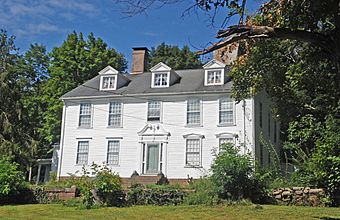Seth Wetmore House facts for kids
Quick facts for kids |
|
|
Seth Wetmore House
|
|

In 2016
|
|
| Location | CT 66 and Camp Rd., Middletown, Connecticut |
|---|---|
| Area | less than one acre |
| Built | 1742 |
| NRHP reference No. | 70000689 |
| Added to NRHP | September 10, 1970 |
The Seth Wetmore House is a historic home built in 1746 in Middletown, Connecticut. It's a great example of a "Center-Hall Colonial" house, which means it has a main hallway right in the middle. The house was built using strong wood frame and post and beam construction. Its outside walls are made of Clapboard siding, and it sits on a Brownstone foundation. The house was officially added to the National Register of Historic Places on September 10, 1970, which means it's recognized as an important historical building.
Contents
Who Was Seth Wetmore?
The Seth Wetmore House was built by Judge Seth Wetmore (1700–1788) in 1746. Judge Wetmore was a very important person in his community. He served as a "deputy" to the General Assembly for 48 terms. This means he was elected many times to represent his town in the state's main law-making group. He was also a Judge of the County Court in Hartford, where he helped make important legal decisions.
A Special House Design
The Seth Wetmore House was likely one of the grandest homes in Middletown when it was built. Today, it's still considered the best example of "high style Georgian architecture" in the area. Georgian architecture was a popular building style in the 1700s, known for its balanced and grand look.
The inside of the house is just as impressive as the outside. One room, the northeast parlor, is especially famous for its beautiful decorations. It has a special corner cupboard shaped like a shell with a "sun-burst" design. There are also fancy fluted columns next to the fireplace, made to look like marble. Above the fireplace, there's an original painting. All the wooden parts in this room are still in their first condition and are very well kept.
Who Built It?
Even though we don't know the name of the person who built this house, it's clear they were a very skilled builder, or "master joiner." There was another house, the William Cooper House (which was torn down in 1930), that looked so much like the Seth Wetmore House that many believe the same person built both of them.
Famous Visitors and Family History
The Seth Wetmore House stayed in the Wetmore family for more than 200 years! Many interesting stories and traditions are connected to the house. It's said that several famous people visited the house, including:
- Jonathan Edwards, a famous religious leader.
- Timothy Dwight IV, a president of Yale University.
- Aaron Burr, a well-known American politician.
- General Lafayette, a French hero who helped America in the Revolutionary War.
There's also a story that a large hemlock tree on the property was planted by Judge Wetmore's daughter, Lucy.
The Judge Seth Wetmore House is important because of its long connection to the Wetmore family and because it's such a wonderful example of Georgian Colonial architecture in Middletown.



